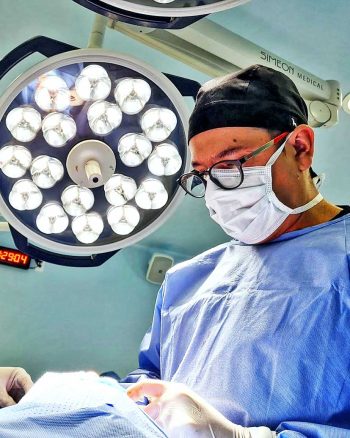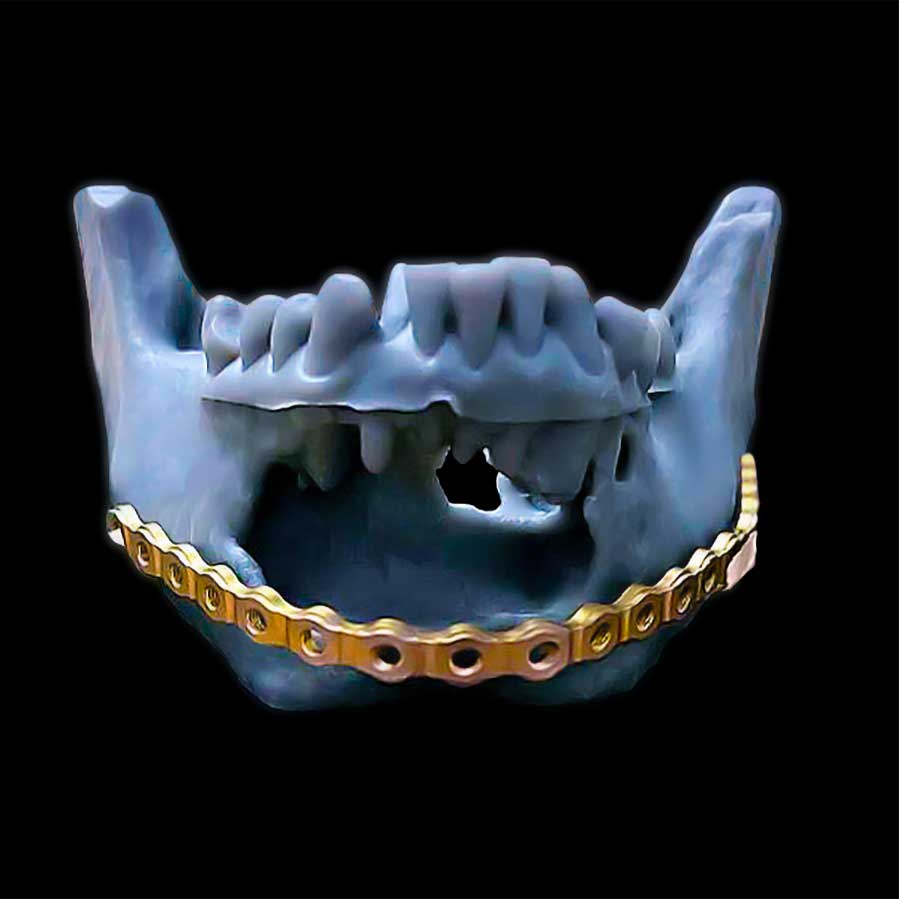Recover the health of your smile! with the correct procedure, saying goodbye to abnormalities, whether congenital or acquired, related to the anatomical structure of the face, jaws, teeth and oral cavity.

Maxillofacial surgery will not only help you achieve adequate functionality and occlusion, but it will also provide you with greater security in life, by recovering the harmony and aesthetics of your smile.
Maxillofacial Surgery is the specialty that treats conditions of the mouth, neck and head.
It deals with the prevention, study, diagnosis, treatment and surgical intervention of all diseases that affect these areas.
Aesthetically, this intervention is recommended in those cases in which there is a dentofacial deformity, that is, when there is a skeletal alteration that modifies the features of the face.
It is recommended in patients who present: too long or short chin or malar hypoplasia.
The treatment is divided into four phases:
1.-Study and planning.
2.-Orthodontics. Only if necessary and can occur before or after the intervention.
3.-Surgical intervention.
4,.Postoperative.
This process depends entirely on the condition of each patient, so the duration of the treatment will depend on the characteristics of each case; In this sense, we make sure that each patient obtains a completely personalized and adequate service.

Dental implants have become one of the best treatment options to replace missing teeth.
The implants, made of titanium, are placed in the jaw bones, from where they serve as the base of the prosthesis or crown, which gives an aesthetic similar to that of natural teeth.
Dental implant surgery is recommended for those looking to ditch uncomfortable dentures and opt for a more comfortable and long-lasting option.
Because the titanium root of the implant is integrated with the bone tissue, it provides greater support, which helps to eliminate discomfort when eating any type of food and when speaking.
And, as if that were not enough, with the necessary care, they can last many years, even a lifetime.
The All on 4 is a cost-effective solution for those who are tired of the limitations of full dentures and for patients with end-stage periodontal disease.
This advanced, minimally invasive implantology technique consists of the placement of four osseointegrated dental implants per arch, which helps to avoid the long waiting times of conventional treatments.
In addition, the patient will leave the surgery with a fixed prosthesis, which will allow him to recover a dental arch with immediate function from the first day of the intervention, without grafts and with only four implants.
Zygomatic implants are the ideal treatment for patients who have partially or totally lost their maxillary bone; as well as for whom bone regeneration techniques, such as grafts or sinus lifts, do not guarantee the expected results.
These implants take their name from the place where they are fixed: the zygomatic bone or cheekbone.
Because only one intervention is needed, patients recover their quality of life immediately.

Dental bone grafting is a necessary surgical procedure in patients with bone loss in the jaws.
Through bone tissue transplantation, diseased or damaged jawbones are repaired and reconstructed, which facilitates bone formation and promotes wound healing.
Often this process is done as part of other dental treatment, especially before dental implants.
In this way, we make sure that the patient has a strong and healthy bone that can support it.

Reconstructive jaw surgery improves the function and aesthetics of congenital deformities or those caused by accidents, burns and pathologies.
This surgical intervention is performed through pre-prosthetic bone graft surgery, together with autologous growth factors or fibrin, and biological membranes, as the case may be.
The main purpose is to restore sufficient bone support to allow proper implant placement and dentofacial harmony and aesthetics, or to restore functionality in cases of sequelae, significant atrophies, and syndromes.
Impacted wisdom teeth are those whose roots are not straight, but due to the little space they tend to curve or turn, that is, they are impacted.
To avoid further complications, it is recommended to extract it before its root structure is fully developed.
To know there is a risk of an impacted tooth, it is recommended, in adolescence, to resort to X-rays, which show the present and future of our teeth.
Cysts and tumors of the jaw are relatively rare lesions that develop in the jaw bone or in the soft tissues of the mouth and face.
They are usually benign, but can be aggressive and spread, displace, or destroy surrounding bone, tissue, and teeth.
That is why an adequate treatment plan is designed for each patient; in some cases, treatment may be medical therapy or a combination of surgery and medical therapy.
This surgical intervention is responsible for correcting dento-cranio-maxillofacial deformities. There are three types of interventions:

A facial trauma occurs in the form of a fracture, when an impact acts on the bone and it cannot absorb it.
It has been detected that the most common causes are traffic accidents and assaults.
Faced with this type of fracture and to avoid long-term problems, such as loss of functionality, irregularities in the bite, and poor aesthetics in the smile, it is advisable to perform an almost immediate surgical intervention to repair the lesion on the face. or the jaw.
For specialized care, before the intervention, a thorough examination must be carried out to determine the exact situation of the affected area.
Maxillofacial surgery will help you raise your smile to another level, giving you self-confidence. We make sure you don’t want to stop smiling.

The All on 4 technique through the placement of dental implants allows the patient to restore dental and facial aesthetics as well as the chewing function when teeth have been lost. In this technique, four dental implants are placed with an angulation and distribution in the dental arch that allows the immediate placement of total screwed prostheses, improving the quality of life of patients who undergo this treatment.
It must be performed by a certified maxillofacial surgeon with experience in dental implants, as well as a specialist in dental rehabilitation, these two specialties working together guarantee success and reduce the rate of complications in the treatment, the surgery can be performed under anesthesia local, and in many cases it can also be performed under conscious sedation with the support of the anesthesiologist, bone anchoring sites are sought in the jaws to avoid the use of bone grafts, in addition adequate stability is achieved in the implants, which allows placement of screwed dental prostheses, so that the patient feels more comfortable during the osseointegration time, which is three months so that the placement of the final prosthesis can be carried out.
Dental implants must be placed within the alveolar bone of the jaws, it is necessary to take into account the different anatomical structures, to avoid complications, for which the surgeon’s experience is of the utmost importance to carry out the procedure safely, there are tools Technological technologies such as the use of surgical guides that make surgery more accurate and allow the surgeon to make less invasive surgical approaches, which benefits the patient during the post-surgery period.
It is important to go to a first assessment to determine the indications prior to surgery since each case must be addressed individually, most of the time we request routine blood tests to avoid surgical complications and in special cases consultation with others is required. specialist doctors to make the procedure safe for the patient.
This depends on the type of surgery that is performed, as well as the skill and experience of the surgeon, but normally the time ranges in surgery are from 30 min to 3 hours. It is important to see certified professionals to avoid complications during or after surgery. surgery, and they come to know that the surgeon has the ability to solve them.
There is no specific age to carry out surgery, rather it depends on the type of pathology that is present and requires surgical treatment, there are pathologies that appear at an early age and others that appear during the growth and development of the patient. The important thing is to follow the diagnosis and planning protocols for surgery, as well as to ensure the adequate state of general health on the part of the patient or, if there are previous diseases, to verify that they are under medical treatment and under control to avoid complications.
There is no treatment that lasts for life, however dental implants are the best tool to replace missing teeth, reporting up to 98% in the success rate, restoring function and aesthetics to patients, it is recommended to go to control appointments to carry out an adequate follow-up and monitoring of the tissues that are related to dental implants, as well as the type of prosthesis used in each case in order to guarantee a long life and success in this type of treatment.
Telephone: +1 305 749 7208
WhatsApp: +52 998 133 4445
Monday Friday: 10:00 a.m. – 06:00 p.m.
Saturday: 10:00 a.m. – 02:00 p.m.
Boulevar Luis Donaldo Colosio # 310 Local 45
Colonia Residencial Cumbres CP. 77560, Cancún, MX.
Copyright ® Top Smile Clinic by Dr. Omar Lugo, Cancun, MX. 2023 | All rights reserved / Notice of Privacy